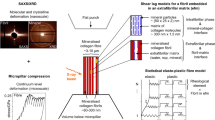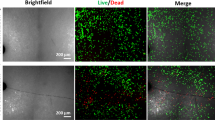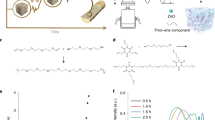Abstract
Properties of the organic matrix of bone1 as well as its function in the microstructure2 could be the key to the remarkable mechanical properties of bone3. Previously, it was found that on the molecular level, calcium-mediated sacrificial bonds increased stiffness and enhanced energy dissipation in bone constituent molecules4,5. Here we present evidence for how this sacrificial bond and hidden length mechanism contributes to the mechanical properties of the bone composite, by investigating the nanoscale arrangement of the bone constituents6,7,8 and their interactions. We find evidence that bone consists of mineralized collagen fibrils and a non-fibrillar organic matrix2, which acts as a ‘glue’ that holds the mineralized fibrils together. We believe that this glue may resist the separation of mineralized collagen fibrils. As in the case of the sacrificial bonds in single molecules5, the effectiveness of this mechanism increases with the presence of Ca2+ ions.
This is a preview of subscription content, access via your institution
Access options
Subscribe to this journal
Receive 12 print issues and online access
$259.00 per year
only $21.58 per issue
Buy this article
- Purchase on Springer Link
- Instant access to full article PDF
Prices may be subject to local taxes which are calculated during checkout



Similar content being viewed by others
References
Burr, D. B. The contribution of the organic matrix to bone’s material properties. Bone 31, 8–11 (2002).
Braidotti, P., Branca, F. P. & Stagni, L. Scanning electron microscopy of human cortical bone failure surfaces. J. Biomech. 30, 155–162 (1997).
Rho, J. Y., Kuhn-Spearing, L. & Zioupos, P. Mechanical properties and the hierarchical structure of bone. Med. Eng. Phys. 20, 92–102 (1998).
Currey, J. D. Sacrificial bonds heal bone. Nature 414, 699 (2001).
Thompson, J. B. et al. Bone indentation recovery time correlates with bond reforming time. Nature 414, 773–776 (2001).
Hassenkam, T. et al. High-resolution AFM imaging of intact and fractured trabecular bone. Bone 35, 4–10 (2004).
Grynpas, M. D., Tupy, J. H. & Sodek, J. The distribution of soluble, mineral-bound, and matrix-bound proteins in osteoporotic and normal bones. Bone 15, 505–513 (1994).
Taton, T. A. Boning up on biology. Nature 412, 491–492 (2001).
Ciarelli, M. J., Goldstein, S. A., Kuhn, J. L., Cody, D. D. & Brown, M. B. Evaluation of orthogonal mechanical properties and density of human trabecular bone from the major metaphyseal regions with materials testing and computed tomography. J. Orthop. Res. 9, 674–682 (1991).
Muller, R. The Zurich experience: one decade of three-dimensional high-resolution computed tomography. Top. Magn. Reson. Imaging 13, 307–322 (2002).
Reilly, G. C. & Currey, J. D. The effects of damage and microcracking on the impact strength of bone. J. Biomech. 33, 337–343 (2000).
Burr, D. B. et al. Does microdamage accumulation affect the mechanical properties of bone? J. Biomech. 31, 337–345 (1998).
Weiner, S., Arad, T., Sabanay, I. & Traub, W. Rotated plywood structure of primary lamellar bone in the rat: Orientations of the collagen fibril arrays. Bone 20, 509–514 (1997).
Nalla, R. K., Kinney, J. H. & Ritchie, R. O. Mechanistic fracture criteria for the failure of human cortical bone. Nature Mater. 2, 164–168 (2003).
Rief, M., Gautel, M., Oesterhelt, F., Fernandez, J. M. & Gaub, H. E. Reversible unfolding of individual titin immunoglobulin domains by AFM. Science 276, 1109–1112 (1997).
Seitz, M., Friedsam, C., Jostl, W., Hugel, T. & Gaub, H. E. Probing solid surfaces with single polymers. Chem. Phys. Chem. 4, 986–990 (2003).
Smith, B. L. et al. Molecular mechanistic origin of the toughness of natural adhesives, fibres and composites. Nature 399, 761–763 (1999).
Becker, N. et al. Molecular nanosprings in spider capture-silk threads. Nature Mater. 2, 278–283 (2003).
Jager, I. & Fratzl, P. Mineralized collagen fibrils: A mechanical model with a staggered arrangement of mineral particles. Biophys. J. 79, 1737–1746 (2000).
Yeni, Y. N. & Fyhrie, D. P. in ASME Bioengineering Conf. Vol. 50 293–294 (ASME, New York, 2001).
Nalla, R. K., Kruzic, J. J., Kinney, J. H. & Ritchie, R. O. Effect of aging on the toughness of human cortical bone: evaluation by R-curves. Bone 35, 1240–1246 (2004).
Raspanti, M., Congiu, T., Alessandrini, A., Gobbi, P. & Ruggeri, A. Different patterns of collagen-proteoglycan interaction: a scanning electron microscopy and atomic force microscopy study. Eur. J. Histochem. 44, 335–343 (2000).
McKee, M. D. & Nanci, A. Osteopontin at mineralized tissue interfaces in bone, teeth, and osseointegrated implants: ultrastructural distribution and implications for mineralized tissue formation, turnover, and repair. Microsc. Res. Tech. 33, 141–164 (1996).
Ferris, B. D., Klenerman, L., Dodds, R. A., Bitensky, L. & Chayen, J. Altered organization of noncollagenous bone-matrix in osteoporosis. Bone 8, 285–288 (1987).
Robey, P. G. et al. Structure and molecular regulation of bone-matrix proteins. J. Bone Min. Res. 8, S483–S487 (1993).
Young, M. F. Bone matrix proteins: their function, regulation, and relationship to osteoporosis. Osteopor. Int. 14, S35–S42 (2003).
Hoang, Q. Q., Sicheri, F., Howard, A. J. & Yang, D. S. C. Bone recognition mechanism of porcine osteocalcin from crystal structure. Nature 425, 977–980 (2003).
Parsamian, G. P. & Norman, T. L. Diffuse damage accumulation in the fracture process zone of human cortical bone specimens and its influence on fracture toughness. J. Mater. Sci.-Mater. Med. 12, 779–783 (2001).
Yeni, Y. N. & Fyhrie, D. P. A rate-dependent microcrack-bridging model that can explain the strain rate dependency of cortical bone apparent yield strength. J. Biomech. 36, 1343–1353 (2003).
Wang, R. Z., Suo, Z., Evans, A. G., Yao, N. & Aksay, I. A. Deformation mechanisms in nacre. J. Mater. Res. 16, 2485–2493 (2001).
Acknowledgements
The authors would like to thank A. Diez-Perez, H. Waite, K. Fields, S. Weiner, M. Rief, W. Landis, P. Fratzl and S. Masahiko for their suggestions and discussion. We also thank Gelson’s Markets, Santa Barbara, especially Phil Vega, for supplying fresh bovine vertebrae. This research was supported by: NASA University Research, Engineering and Technology Institute on Bio Inspired Materials, NIH, NSF, the Institute for Collaborative Biotechnologies from the US Army Research Office, Veeco Instruments, the UCSB Materials Research Laboratory, the NOAA National Sea Grant College Program, US Dept of Commerce through the California Sea Grant College System and a CNPq Fellowship, Brazil. T.H. and H.B. thank the Danish research council for additional support. G.F. thanks the Austrian Academy of Science for a DOC scholarship.
Author information
Authors and Affiliations
Corresponding author
Ethics declarations
Competing interests
The authors declare no competing financial interests.
Rights and permissions
About this article
Cite this article
Fantner, G., Hassenkam, T., Kindt, J. et al. Sacrificial bonds and hidden length dissipate energy as mineralized fibrils separate during bone fracture. Nature Mater 4, 612–616 (2005). https://doi.org/10.1038/nmat1428
Received:
Accepted:
Published:
Issue Date:
DOI: https://doi.org/10.1038/nmat1428
This article is cited by
-
Recent advancement of nanostructured materials: a compatible therapy of tissue engineering and drug delivery system
Polymer Bulletin (2024)
-
Collagen breaks at weak sacrificial bonds taming its mechanoradicals
Nature Communications (2023)
-
Force transmission by retrograde actin flow-induced dynamic molecular stretching of Talin
Nature Communications (2023)
-
Advanced Functional Polymers: Properties and Supramolecular Phenomena in Hydrogels and Polyrotaxane-based Materials
Chemistry Africa (2023)
-
Unraveling the effect of collagen damage on bone fracture using in situ synchrotron microtomography with deep learning
Communications Materials (2022)



